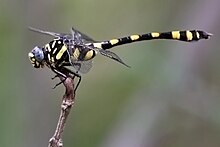Ictinogomphus is a genus of dragonflies in the family Gomphidae.[2][3] They are medium to large, yellow and black with clear wings.[4] Species occur in Africa, Asia and Australia.[4]
| Ictinogomphus | |
|---|---|

| |
| Ictinogomphus rapax (Common Clubtail) | |
| Scientific classification | |
| Domain: | Eukaryota |
| Kingdom: | Animalia |
| Phylum: | Arthropoda |
| Class: | Insecta |
| Order: | Odonata |
| Infraorder: | Anisoptera |
| Family: | Gomphidae |
| Genus: | Ictinogomphus Cowley, 1934[1] |

I. decoratus melaenops male
Thailand
Species
editThe genus Ictinogomphus includes the following species:[2]
- Ictinogomphus alaquopterus Yousuf & Yunus, 1976
- Ictinogomphus angulosus (Selys, 1854)
- Ictinogomphus australis (Selys, 1873) - Australian tiger[4]
- Ictinogomphus celebensis (Schmidt, 1934)
- Ictinogomphus decoratus (Selys, 1854) - common flangetail
- Ictinogomphus dobsoni Watson, 1969 - Pilbara tiger[4]
- Ictinogomphus (Cinitogomphus) dundoensis (Pinhey, 1961) - Swamp Tigertail[5]
- Ictinogomphus ferox (Rambur, 1842) - common tiger, common tigertail[6]
- Ictinogomphus fraseri Kimmins, 1958
- Ictinogomphus kishori Ram, 1985
- Ictinogomphus paulini Watson, 1991 - Cape York tiger[4]
- Ictinogomphus pertinax (Hagen in Selys, 1854)
- Ictinogomphus pugnovittatus Yousuf & Yunus, 1976
- Ictinogomphus rapax (Rambur, 1842) - common clubtail[7]
- Ictinogomphus regisalberti (Schouteden, 1934)
- Ictinogomphus tenax (Hagen in Selys, 1854)
Notes on taxonomy
editJules Rambur originally described this genus as Ictinus in 1842.[8] However, at the time there already existed a genus of beetle also named Ictinus described by François Laporte in 1834.[9] In 1934, John Cowley, an English entomologist, renamed this species to Ictinogomphus in deference to Rambur's original name. Cowley is now regarded as the authority, and this genus can be formally written as: Ictinogomphus Cowley, 1934.[3]
Up until recently, species of Ictinogomphus were sometimes considered to be in the family Lindeniidae.[4] Lindeniidae is no longer recognised as a family, and Ictinogomphus is now found in the family, Gomphidae.[10]
References
edit- ^ Cowley, J. (1934). "The types of some genera of Gomphidae (Odonata)". The Entomologist. 67: 273–276 [274].
- ^ a b Paulson, D.; Schorr, M.; Abbott, J.; Bota-Sierra, C.; Deliry, C.; Dijkstra, K.-D.; Lozano, F. (2024). "World Odonata List". OdonataCentral, University of Alabama.
- ^ a b "Genus Ictinogomphus Cowley, 1934". Australian Faunal Directory. Australian Biological Resources Study. 2012. Retrieved 1 September 2024.
- ^ a b c d e f Günther Theischinger; John Hawking (2006). The Complete Field Guide to Dragonflies of Australia. CSIRO Publishing. ISBN 0-643-09073-8.
- ^ Clausnitzer, V.; Suhling, F. & Kipping, J. (2010). "Ictinogomphus dundoensis". IUCN Red List of Threatened Species. 2010: e.T63190A12615558. doi:10.2305/IUCN.UK.2010-3.RLTS.T63190A12615558.en.
- ^ Clausnitzer, V.; Suhling, F.; Dijkstra, K.-D.B. (2016). "Ictinogomphus ferox". IUCN Red List of Threatened Species. 2016: e.T59894A85585956. doi:10.2305/IUCN.UK.2016-3.RLTS.T59894A85585956.en.
- ^ Subramanian, K. A. (2005). Dragonflies and Damselflies of Peninsular India (PDF).
- ^ Rambur, Jules (1842). Histoire naturelle des insectes. Névroptères (in French). Paris: Librairie Encyclopédique de Roret. pp. 534 [171] – via Gallica.
- ^ Laporte, F. (1834). Audouin, J.V.; Brullé, G.A. (eds.). Histoire naturelle des insectes, traitant de leur organisation et de leurs moeurs en général, par M. V. Audouin et comprenant leur classification et la description des espèces, par M. A. Brullé. Paris: F.D. Pillot. pp. 479 [259]. doi:10.5962/bhl.title.34228 – via Biodiversity Heritage Library.
- ^ Dijkstra, Klaas-Douwe B.; Bechly, Günter; Bybee, Seth M.; Dow, Rory A.; Dumont, Henri J.; Fleck, Günther; Garrison, Rosser W.; Hämäläinen, Matti; Kalkman, Vincent J.; Karube, Haruki; May, Michael L.; Orr, Albert G.; Paulson, Dennis R.; Rehn, Andrew C.; Theischinger, Günther (2013). "The classification and diversity of dragonflies and damselflies (Odonata). In: Zhang, Z.-Q. (Ed.) Animal Biodiversity: An Outline of Higher-level Classification and Survey of Taxonomic Richness (Addenda 2013)". Zootaxa. 3703 (1): 36–45. doi:10.11646/zootaxa.3703.1.9. hdl:10072/61365. ISSN 1175-5334.
External links
editMedia related to Ictinogomphus at Wikimedia Commons
Data related to Ictinogomphus at Wikispecies